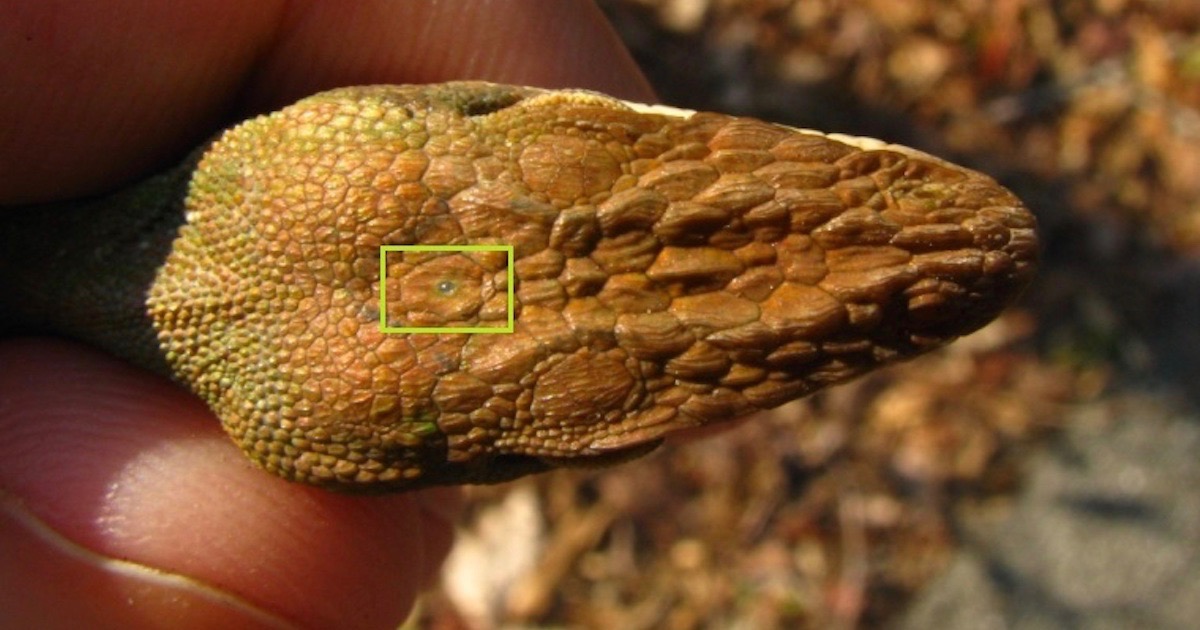
Yes, four eyes. From Gunter Bechly at ENST:
Based on two fragmentary fossils, Smith et al. (2018) just described the new monitor lizard Saniwa ensidens from the 49 million year old Bridger Formation in Wyoming. Both known specimens surprisingly had four eyes! Additional to the normal pair of lateral lens eyes, and the usual parietal third eye of lizards, this new species actually had a forth pineal eye like a lamprey. Not a single other jawed vertebrate has something remotely like this, even though this fossil lizard is the closest relative of the modern monitor lizard genus Varanus and thus deeply nested within modern land vertebrates.

What? This sounds almost too weird to be true. Yet since the article was published on April 2, 2018, in the prestigious journal Current Biology it is definitely not an April Fools’ prank. The authors bite the bullet and boldly propose that the extinct monitor lizard re-evolved a fourth eye from the pineal organ, similar to the assumed ancestral state in lampreys. This means that even though a pineal eye was at least lost since the origin of tetrapods about 390 million years ago, 340 million years later just another ordinary species of monitor lizards came along and said, “Hey, what about having four eyes again?” It then re-evolved this organ that was obviously not of any sufficient adaptive value to any other tetrapod in the history of life to let evolution’s unlimited creative power do its magic. Nevertheless, this remarkable effort did not save this species from extinction without any surviving descendants, while numerous monitor lizards without fouth eye were more lucky. More.
Of course, the big problem, as Bechly points out, is that finds like this cast doubt on the Darwinian concept of the nested hierarchy (an orderly classification resulting from common descent, in which characteristics acquired through natural selection acting on random mutations are neatly organized according to where they appear on the branch of the tree).
Paper: Krister T. Smith, Bhart-Anjan S. Bhullar, Gunther Köhler, Jörg Habersetzer. The Only Known Jawed Vertebrate with Four Eyes and the Bauplan of the Pineal Complex. Current Biology, 2018; 28 (7): 1101 DOI: 10.1016/j.cub.2018.02.021 open access From ScienceDaily:
“On the one hand, there was this idea that the third eye was simply reduced independently in many different vertebrate groups such as mammals and birds and is retained only in lizards among fully land-dwelling vertebrates,” says Krister Smith at the Senckenberg Research Institute in Germany. “On the other hand, there was this idea that the lizard third eye developed from a different organ, called the parapineal, which is well developed in lampreys. These two ideas didn’t really cohere.
“By discovering a four-eyed lizard — in which both pineal and parapineal organs formed an eye on the top of the head — we could confirm that the lizard third eye really is different from the third eye of other jawed vertebrates,” Smith continues. More.
In short, it is not a neatly nested hierarchy; it is convergent evolution: The trait results from a common goal, not common ancestry. But that is not Darwinism and it is unclear how the resources for all this varied design arise.
See also: Fossil dragonfly named in Mike Behe’s honor has implications for ID
and
Evolution appears to converge on goals—but in Darwinian terms, is that possible?